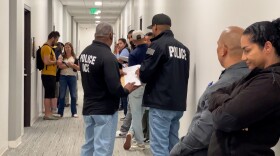Plenty of politicos and pundits have rationalized Donald Trump's political ascent as the result of his enormous popularity among white, working-class voters.
No doubt, Trump is well liked by many college-educated Republicans, but, his real strength is among those without a bachelor's degree. In that demographic, most polls show the business-mogul-turned-GOP-presidential-candidate is trouncing his Republican rivals.
In fact, the main reason Trump is leading national polls is because he dominates the white, non-college world.
So, that got us thinking — how powerful are white, non-college voters? And, what role do they play in the GOP of today versus the GOP of yesterday?
Reliably Republican — And Shrinking
In 1980, whites without a college degree made up almost two-thirds of the electorate (65 percent). Back then, both Ronald Reagan and Jimmy Carter relied heavily on white, working-class voters — 60 percent of Carter voters were whites without a college degree, compared to 70 percent of Reagan voters. Keep in mind, Reagan won that election in a landslide.
Jump ahead a few decades, dig through exit polls, and you'll find a very different political landscape.
"The electorate as a whole has gotten both more highly educated and also more diverse," explained Jocelyn Kiley, a researcher who focuses on U.S. politics at the Pew Research Center, who helped us dig through the data.
In the 2012 generational election, half of Mitt Romney's supporters were whites without a college degree, compared to about a quarter of Obama voters. And, yet, Romney still lost the presidency — and by an Electoral College landslide.
That's because white, blue-collar voters are a shrinking share of the voting pool.
At the same time, as their population shrinks, they've also become more faithfully Republican.
"My contention is that what Reagan did was he brought a new group of people into the Republican Party, and that has grown and has become more significant," explained Democratic pollster Peter Hart. "It is less establishment; it is more what I call downscale, blue-collar non-establishment."
Another way to think about this is that while white, working-class voters are now only about a third of the overall electorate, they're about half of the Republican electorate.
"They remain an important part of the GOP base," Kiley said. "And, it's a large part of why there's been so much attention to them in the Republican primary."
Working-class voters are still a bedrock of the GOP in two states candidates really want to win — Iowa and New Hampshire. They made up nearly half of Republicans in the 2012 Iowa caucus and 45 percent of voters in the 2012 New Hampshire primary.
And, so while mathematically, a candidate can no longer win a general election with their support alone, it's also nearly impossible for a Republican presidential candidate to win a GOP primary without them. The road to the GOP nomination travels through many white-working class neighborhoods. And that's one reason it's been difficult for the party to expand its base.
New Factor — The Hyper-Educated And The Educational Divide
White voters without college degrees are an important component of the GOP coalition, but an overreliance on them can also be a crutch when hyper-educated and nonwhite populations are growing — and becoming increasingly Democratic.
In general, whites tend to vote Republican more than people of color across educational backgrounds. In 2012, just over half of Obama voters were white, while 89 percent of Romney voters were. So, even among white college graduates, Republicans do better than Democrats, with one caveat — people with post-graduate degrees.
"Post-graduates today are overwhelmingly Democratic or lean Democratic in their partisan identification, to much a greater extent than they were 20 years ago," said Kiley, who traced data back to 1988.
In recent years, the correlation between party ID and educational attainment has grown. Essentially, the education gap has morphed into an education gulf. White women with advanced degrees are now one of the most faithful Democratic subgroups. According to data from the Pew Research Center, 62 percent are Democratic or lean Democratic.
In the 2012 election, there was a 30-point margin between how whites with a post-grad degree voted compared to whites with no college degrees.
But, a GOP voter today is more likely to be white and working class than a Democratic voter — and they still hold more political power than hyper-educated white voters. So the candidate who can connect with them has an edge in the GOP primary — even though it might hurt them in a general election.
Copyright 2016 NPR. To see more, visit http://www.npr.org/.






